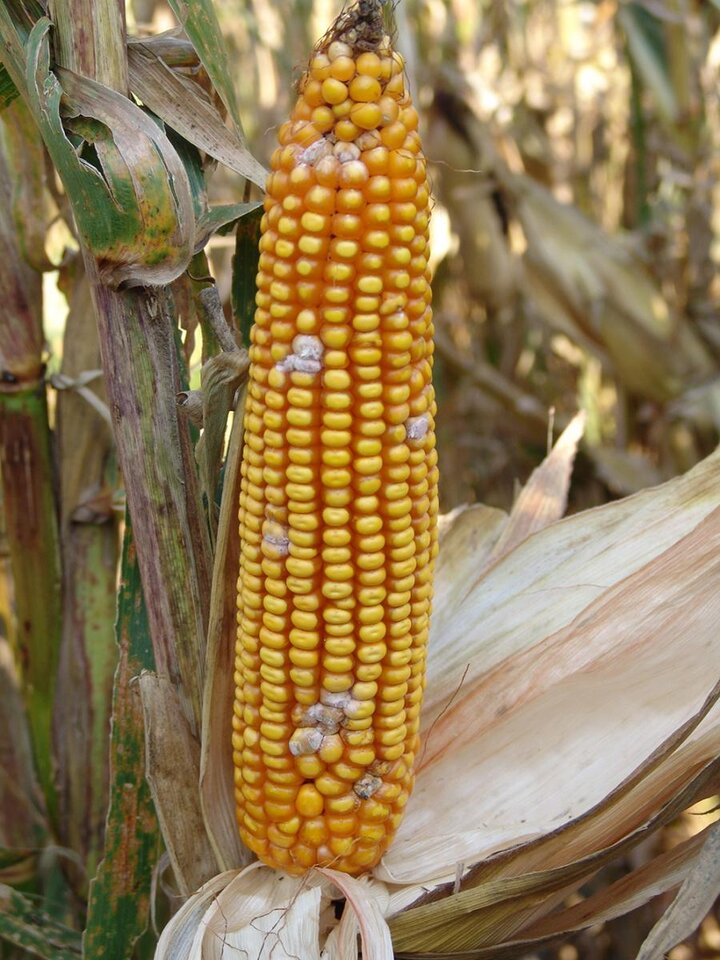

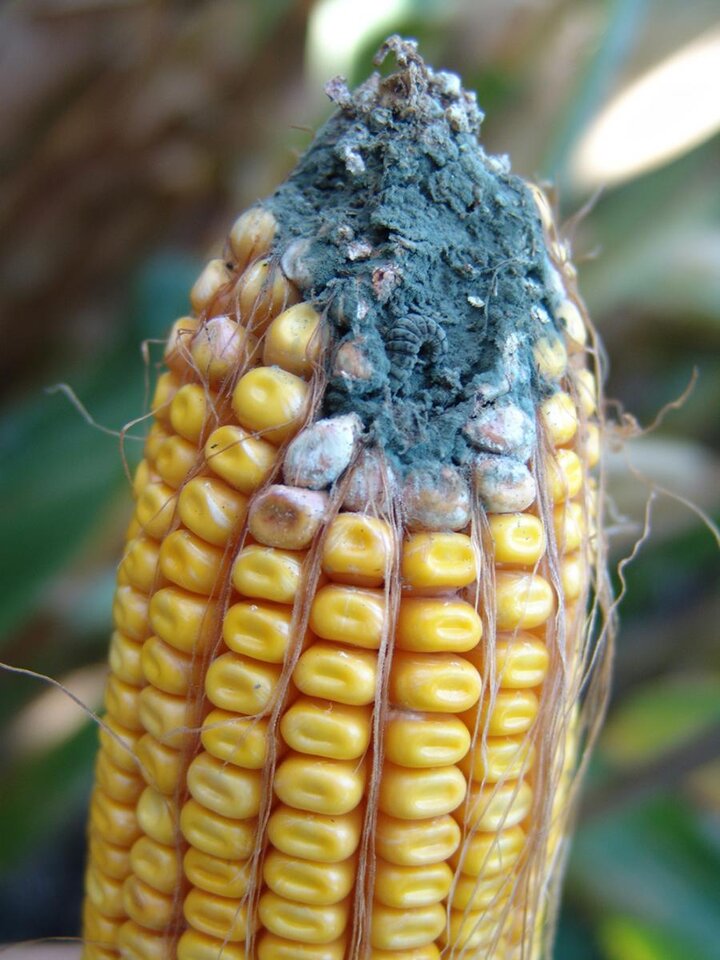
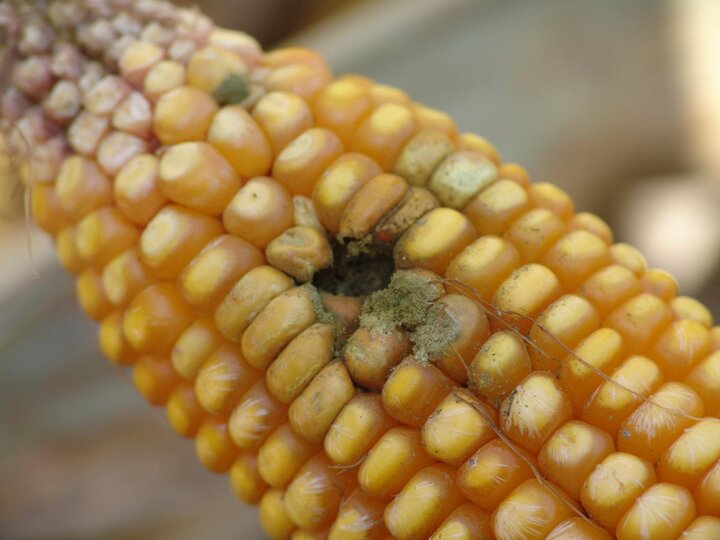
Ear rot diseases have been observed in some areas of Nebraska and stalk rot diseases are becoming increasingly common. It’s important to scout for stalk rot diseases now to determine which fields are at greatest risk of lodging and should be harvested first. Although it is unknown if ear rot diseases are widespread, it’s also important to scout for ear rot diseases to know how to better handle affected grain at harvest to prevent or minimize impacts on grain quality. Fields at higher risk include those that sustained injury due to hail or insect feeding during the cropping season, such as that caused by grasshoppers or western bean cutworm, as wounding can often promote infection by ear rot fungi.
Also see:
Husks of affected ears may be discolored before healthier ears in the field or turn downward early. Some fungal growth may only be evident after husks are opened to reveal cottony fungal growth that can vary in color. Ear rot diseases may cause yield loss and reduce grain quality. Ear rot diseases are caused by several species of fungi that can continue growing in stored grain, further reducing quality. In addition, some fungi may produce secondary mycotoxins that can be harmful at higher concentrations to livestock and other consumers. The presence of ear rot fungi does not necessarily mean that mycotoxins are also present. Knowing which ear rot fungi are present can help predict which, if any, mycotoxins may be present. Mycotoxin levels can be measured by certified labs testing suspect ears. Ear rot diseases and mycotoxins occur to some extent every year, usually at safe levels.
Fusarium Ear Rot
Fusarium and Gibberella ear rot are common diseases in corn. Fungi causing these diseases may infect any part of the ear and take advantage of wounds created by insects or hail (Figure 1). These fungi are favored by a wide range of environmental conditions and can be recognized by scattered tufts of mold on the ears that may be white to pink and accompanied by starburst patterns on the kernels. The fungal species causing these diseases can also produce mycotoxins called fumonisin or vomitoxin (also called deoxynivalenol or DON) in the grain. Food and Drug Administration (FDA) guidance for fumonisin in animal feed ranges from 5-100 parts per million (p.p.m.). FDA advisory levels for vomitoxin/DON are 1 p.p.m. for human consumption and range from 5-30 p.p.m. for animal consumption.
Diplodia Ear Rot
Diplodia (also called Stenocarpella) ear rot is a common disease in the Corn Belt. The fungus that causes this disease does not usually produce a mycotoxin in the United States, but can significantly reduce grain quality. Extensive fungal growth usually begins at the base of the ear and can overtake the entire ear, creating a lightweight mummified ear (Figure 2). In addition to these symptoms, this disease can be recognized by the production of small raised, black fungal reproductive structures on infected kernels and stalks giving it a rough feeling similar to sandpaper. Diplodia can cause 'fines' from kernels and cobs falling apart. See manufacturer’s guidelines regarding how to increase your combine fan speed to help remove these fine materials and severely infected kernels that are usually lighter than healthy kernels.
Penicillium Ear Rot
The fungus causing Penicillium ear rot can lead to blue-green spore development where it infects, especially on wounded kernels, such as on ear tips (Figure 3). This disease is particularly a storage problem and is favored by high moisture levels in grain bins. This disease is managed by reducing insect wounding of ears in the field and by maintaining low moisture in stored grain. Because of their similar appearances, Penicillium ear rot may be misdiagnosed as Aspergillus ear rot.
Aspergillus Ear Rot
Aspergillus ear rot is caused by the fungus Aspergillus flavus that may infect wounded kernels and produces green-yellow spores (Figure 4). This ear rot can be observed after hot, dry weather during the latter half of the growing season after pollination. Drought-stressed corn, such as that in non-irrigated fields and pivot corners, are especially vulnerable to this disease. Aspergillus flavus can also produce the mycotoxin aflatoxin. Aspergillus ear rot and aflatoxin have NOT been confirmed in Nebraska corn this year. Aflatoxin is toxic and carcinogenic to humans and livestock. The FDA has suggested action levels for aflatoxin concentrations, ranging from 0.5-20 parts per billion (p.p.b.) for human consumption and 20-300 p.p.b. for animal consumption, depending upon its intended use, such as the species and age of the animal.
Grain Handling and Management During Storage
Ear rot pathogens will usually continue to grow to some extent during grain storage. However, taking extra steps can minimize fungal growth and contamination of unaffected grain and potential deductions at the elevator. Drying grain to less than 15% moisture and cooling to 50°F as soon as possible after harvest is necessary to slow mold growth. Grain for longer term storage should be cooled to 30°F and dried to 13% moisture. As ear rots and grain molds are more likely to worsen in storage, you should only store the highest quality grain and not mix it with other grain affected more severely with ear rot pathogens.
In addition to storage in bins, storing the grain in bags for silage, earlage, etc., to promote fermentation will only hasten the growth of these fungi when grain moisture is high and temperatures are still warm. Eventually, once oxygen is depleted and fermentation begins, it may slow mold growth, but the process may take several days to weeks, during which time the environment inside the bag can act as an incubator for fungi, allowing them to grow even more rapidly than they would inside a bin.
Testing for Mycotoxins
How do you know when to test for mycotoxins? Information from the Crop Protection Network suggests if 30% of ears in your field have Gibberella or Fusarium ear rots, test for DON/vomitoxin and fumonisins. Testing your corn is also recommended if you observe multiple ears with more than 50% of the ear covered with either Gibberella or Fusarium fungi. If you find any ear with Aspergillus ear rot, test the harvested grain for aflatoxin.
Several certified labs in Nebraska can provide mycotoxin testing of affected grain. The following companies have been certified by the U.S. Grain Inspection, Packers and Stockyards Administration (GIPSA) for mycotoxin testing:
- Fremont Grain Inspection, 603 East Dodge St., Fremont, 402-721-1270
- Hastings Grain Inspection, 306 E. Park St., Hastings, 402-462-4254; Grand Island office at 315 S. Locust St, Grand Island, 308-384-2174
- Kansas Grain Inspection Service, 517 13th Ave., Sidney, Nebr., 308-254-3975
- Lincoln Inspection Service, 505 Garfield St., Lincoln, 402-435-4386
- Omaha Grain Inspection Service, 2525 South 13th St., 402-341-6733
- Sioux City Inspection and Weighing Service, 840 Clark St., Sioux City, Iowa, 712-255-8073
Additional official USDA Grain Inspection, Packers & Stockyards Administration (GIPSA) service providers are available in other states.
Testing using only the black light method is inaccurate because it detects fluorescence of a chemical that is produced by many fungi, not just Aspergillus spp., thus it does not accurately predict the presence or concentration of aflatoxin or other mycotoxins.
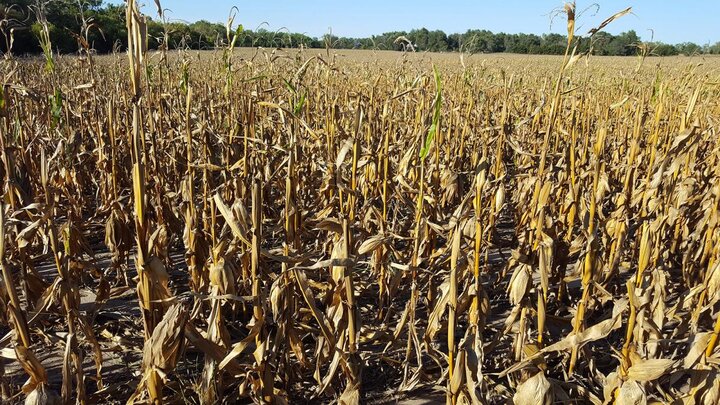
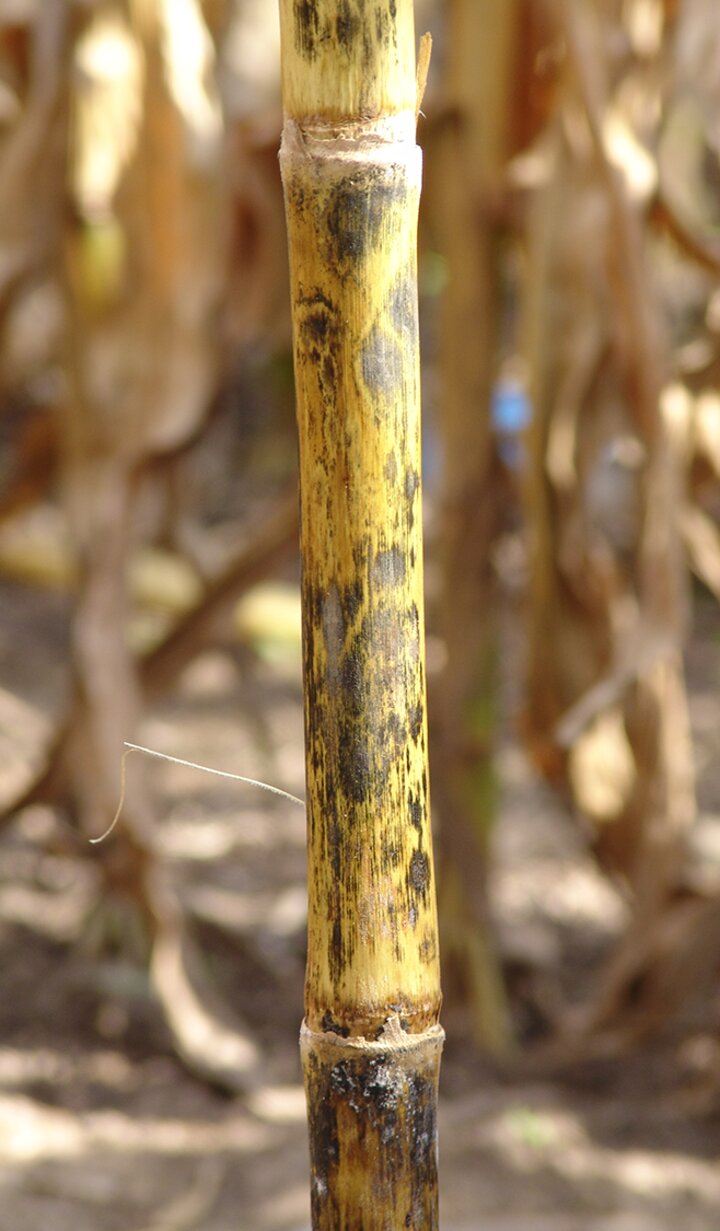
Stalk Rot Diseases
Anthracnose stalk rot (with top dieback symptoms caused by the fungus Colletotrichum graminicola) has been especially common this year. The disease can cause the premature death of several internodes above the ear, causing the top of the plant to brown while the lower plant remains green. During late season, the plant tops may break off (Figure 5). Black lesions may develop at the nodes initially and spread to the lower internodes later in the season (Figure 6). The black discoloration is the pigmented fungal strands (hyphae) that may accumulate either on the outside or inside of the stalk as the fungus systemically colonizes the stalk. Although the fungus can also cause a leaf blight disease, it is not correlated well with later stalk rot development. The fungus may infect directly through the epidermis of the plant stalk or roots from infected buried debris or via wounds. Affected stalks often have the pith area rotted out, compromising the overall stalk strength. They may lodge or are easily crushed by hand and can be evaluated using the push or pinch tests while walking through the field. (See this Sept. 16 Market Journal video on testing for stalk rot.)
Resistant hybrids can be effective in reducing Anthracnose stalk rot disease, although resistance to the leaf blight phase is not well correlated with resistance to the stalk rot phase of this disease. Most commercially available hybrids have some resistance and do not develop the disease until late season.
More Resources
These Nebraska Extension publications on corn diseases can be helpful in differentiating numerous stalk and ear rot diseases:
- Common Stalk Rot Diseases of Corn (EC1898)
- Corn Disease Profile III — Ear Rot Diseases and Grain Molds (EC1901)
- Corn Disease Profile II — Stalk Rot Diseases (EC1868)
The Crop Protection Network provides additional information on ear rots and mycotoxins.
The Corn Disease Management section within Plant Disease Management in CropWatch.
